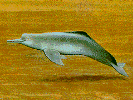
While they rarely jump out of the water or lift their tails like other dolphins, botos can be playful, sometimes cavorting with river turtles and tossing them into the air. The researchers watched them throw sticks and play with logs, pull grass underwater, grab fishermen's paddles and rub against their canoes. Some fishermen even taught wild botos to herd and capture fish.
Slow-moving, botos lope along at about 1.5 to 3.2 kmh. In a sprint, they can briefly reach speeds of up to 14 kmh. Since they have to navigate the rapids in some of the upper-Amazon and Orinoco tributaries, botos are, by necessity, strong swimmers.
The boto's reputation is enhanced by legend and myth. In one story, the boto takes the form of a man and seduces unmarried girls with his captivating charm. In another, the dolphin becomes a mermaid, luring young men into the water.
Inia geoffrensis
Size: 2 to 2.5 m, 85 to 160 kg
Calves at birth: 70 to 83 cm
Teeth: 24 to 32 teeth on each side of upper and lower jaws, with
simple, conical teeth near the front and heavier molar-type
teeth in the back
Food: Fish such as armoured catfish and at least 50 other species
Habitat: Rivers
Range: The Amazon and Orinoco river systems in Brazil, Venezuela,
Colombia, Ecuador, Guyana, Peru and Bolivia
Status: Vulnerable. Numbers unknown
